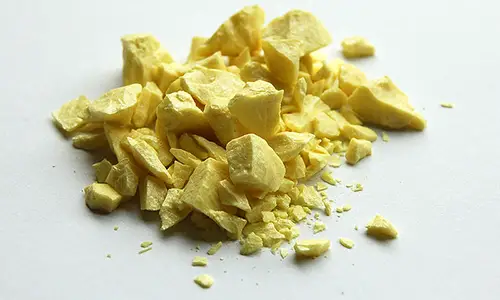1.A Natural Element
Sulfur is an element that occurs naturally but it is also found in several compounds or can be extracted from other common minerals. Sulfur has a non-metallic bright yellow color. It is an element that has an atomic number of 16. The term sulfur is derived from ‘sulvere’, a Sanskrit word.
2.An Ancient Element
Sulfur has been around for many centuries and is mentioned severally in the Torah and the Bible. In the 6th B.C., China was already using one allotrope of sulfur. Sulfur is called ‘brimstone’ in Biblical terms and in ancient times; it was used for varying purposes.
3.Important for Living Organisms
Though sulfur works well as both a reducing agent and an oxidant, it is important for the survival of living organisms. It is thought to be the 7th most abundant element in human bodies. A person who weighs 150 pounds has an estimated 140 grams of sulfur in the body. Both animals and plants need sulfur to create amino acids in order to form enzymes, proteins and other elements. There are typical vitamins that contain sulfur, these include thiamine and biotin.
4.Sulfur presence in the Universe
The yellow color that is seen on Jupiter’s moon is as a result of sulfur’s presence in various forms and states. Sulfur is known to be present in numerous meteorites and is often seen on Earth along the edges of hot springs and volcanoes. Sulfur is also generated inside huge stars at extremely high temperatures. This happens when a helium nucleus fuses with a silicon nucleus.
5.Sulfur Cycle
The sulfur cycle became the very first biogeochemical cycle that was ever discovered. In this cycle, bacteria consume sulfur then they oxidize inorganic compounds. Despite the fact that sulfur was being used for a millennium, in 1777, Antoine Lavoisier managed to convince scientists that it is an element. Sulfur is a non-toxic element, is compounds, sulfuric acid and sulfurous acid are present in acid rain.
6.Sulfur can turn Toxic
When in hydrogen sulfide form, sulfur can become toxic and cause death as a result of respiratory failure. Sulfur dioxide also occurs in acid raid as well as air pollution that happens in atmospheric levels.
7.Pure Sulfur does not Smell
Pure sulfur has no stench and the smell in impure sulfur comes from numerous other compounds that are in it. Mercaptans, a sulfur compound gives skunks the odor and stink bombs or rotten eggs get their smell from hydrogen sulfide, a sulfur compound.
8.Common Uses
As a non-metal, sulfur ranks 10th in terms of abundance in the universe. In the modern world, sulfur is commonly used to manufacture sulfuric acid that is in turn used to produce cleaners, batteries and fertilizers. Sulfur is also used to process ores and refine oil.
9.Fumigating Homes
In ancient times, sulfur dioxide was used to fumigate homes. This practice continued into the nineteenth century. In an 1889 paper, a New York City health inspector explained the burning alcohol and sulfur in homes that were affected by measles, smallpox, diphtheria and scarlet fever.
10.Hot Springs have plenty of Dissolved Sulfur
Hot springs have a lot of sulfur compounds dissolved in them that may have dubious smell. Despite this, hot springs have been credited for their medicinal qualities. The hot sulfur springs town in Colorado for instance came up in 186o following the discovery by white settlers of sulfur springs where Ute Indians are said to have been soaking for centuries. In addition, it is said that sulfur can cause shipwrecks such as the Swedish Warship that sank in 1628.











Leave a Reply